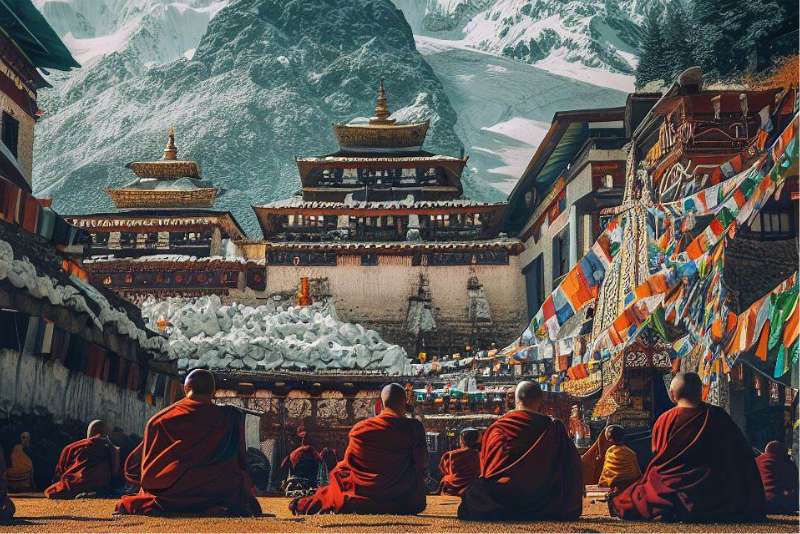Overview
Nestled in the foothills of the Himalayas in Northeastern India, the small state of Sikkim has a long and fascinating history. For centuries, it existed as an independent Buddhist kingdom ruled by the Namgyal dynasty until political winds shifted Sikkim towards democracy and ultimately integration with India in 1975. Despite its modest size, Sikkim’s strategic location, unique cultural heritage, and biodiverse landscape have contributed to a rich historical narrative full of intrigue.
Early History: Buddhism and the Namgyal Dynasty
Sikkim’s early history is steeped in Buddhist legend and mythology. The most significant figure is Guru Rinpoche, an 8th-century Buddhist master credited with introducing Tantric Buddhism to the Himalayan region, including Sikkim. Considered the founder of Sikkim, Guru Rinpoche is believed to have flown to the present-day state on the back of a tiger to bless the land. Over subsequent centuries, his disciples and followers established monasteries, centres of Buddhist learning, and sacred pilgrimage sites throughout Sikkim.
The Namgyal dynasty, which would rule Sikkim for over 300 years, traced its origins to Guru Rinpoche as well. Legends speak of how Khye-Bumsa, a 14th-century prince from Tibet married a local Sikkimese woman and fathered three sons, one of whom started the Namgyal dynasty in the 17th century. Over the next 200 years, the Namgyal kings expanded Sikkim’s boundaries by annexing neighbouring territories and consolidating their centralized authority despite regional instability and conflict. Pingal-Descents from Guru Rinpoche shaped both the spiritual and political foundations of Sikkim.
While most early inhabitants followed the animist Lepcha religion, Buddhism flourished under the Namgyals, profoundly shaping Sikkimese culture and national identity. Monasteries like Pemayangtse and Rumtek became hubs of Tibetan Buddhist spirituality, art, education and power. By the 19th century, through royal patronage and monastic networks, the Namgyal dynasty established firm control over Sikkim as a distinct Buddhist kingdom India with close ties to Tibet.
British Protectorate and Colonial Rule
In the early 19th century, British interest in Sikkim grew for economic and geopolitical reasons amid rising tensions between the British Raj and an expanding Nepal. After Nepal invaded Sikkim in 1792, the embattled Chogyal or King of Sikkim appealed to the British for help, leading to British mediation and the establishment of Sikkim as a British protectorate in 1861.
The British deployed political officers in Sikkim’s capital Gangtok to advise the Chogyal on governance and exercise control over external affairs. British infrastructure projects like roads and railways helped connect Sikkim’s economy but also enabled tighter British control and imported colonial values. However, the British trod delicately, stopping short of direct interference in internal affairs out of respect for local sensitivities. Nevertheless, introducing Western education and ideas weakened traditional feudal structures, setting the stage for Sikkim’s eventual transition to democracy.
The transition from Monarchy to Indian State
In 1947, with British India’s independence, Sikkim negotiated fresh terms with the newly independent India, allowing the monarchy and domestic autonomy to continue while ceding external affairs like defence and foreign policy to India. However, winds of democracy sweeping India kindled aspirations in Sikkim too.
In the 1960s and early 1970s, as the Chogyal resisted reforms, tensions erupted between pro-democracy reformists favouring integration with India versus traditional elites wanting to preserve Sikkimese sovereignty under the Namgyal dynasty. Amidst riots, instability, and allegations of authoritarianism, the embattled Chogyal agreed to a democratic referendum. In 1975, an overwhelming majority of Sikkimese people voted to abolish the monarchy and merge with India. Sikkim was established as the 22nd state of India under a democratic constitution.
Modern Sikkim as Part of Democratic India
As part of modern India over the past few decades, Sikkim has undergone major political, social, and economic changes through embracing democracy, infrastructure development, and openness to globalization. Educational and employment opportunities have expanded greatly while traditional modes of subsistence agriculture and trans-Himalayan trade networks diminished.
Rapid development has also brought its share of challenges like rampant urbanization, loss of indigenous languages, and connections to the environment. However, amidst the winds of change, Sikkim has retained its distinctive identity and roots. Buddhism continues to be practiced widely with monasteries thriving as community hubs. Sikkim’s spectacular and biodiverse mountain landscape, along with its charming blend of Tibetan, Nepali, and Lepcha cultures makes it a leading tourist destination.
Conclusion
Sikkim’s multi-layered history reveals the ability of a small Sikkim Buddhist kingdom India to adapt to shifting tides and reinvent itself, while tenaciously preserving a strong sense of culture and identity. The Namgyal dynasty presided over centuries of cultural efflorescence and consolidation of centralized power. Then British colonial influence and the forces of democracy led Sikkim towards integration with India. As Sikkim celebrates its past and navigates its future as one of India’s most unique states, its rich history will continue to fascinate people worldwide.
If you enjoyed reading this glimpse into Sikkim’s storied past, visit here to dive deeper into the full history of this fascinating Himalayan state, from its Buddhist origins to its integration into modern India. The rich story continues!












